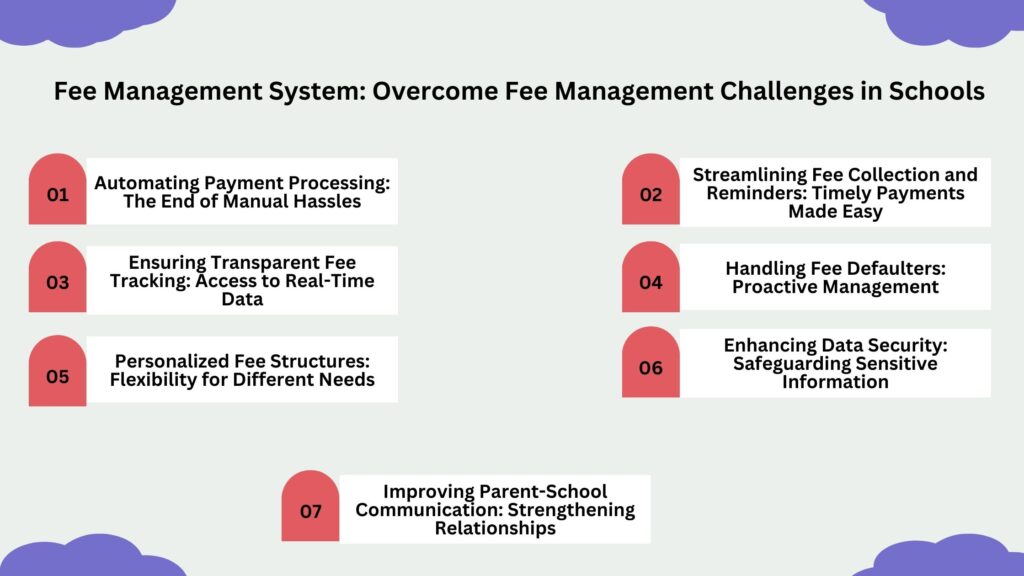Are you tired of grappling with the complexities of fee management in schools?
As educational institutions strive to provide quality education and a conducive learning environment, the task of managing fees efficiently has become a significant challenge. With various stakeholders involved, including parents, administrators, and financial departments, the process demands a seamless and transparent approach.
The top challenges in fee management often revolve around late payments, errors in billing, tracking outstanding dues, and maintaining accurate financial records. However, in this ever-evolving digital age, solutions are at hand – a fee management system.
By harnessing technology and adopting innovative systems, schools can streamline their fee management processes and overcome these obstacles. In this article, we explore the prevailing challenges in fee management and delve into effective strategies to triumph over them, ensuring a smoother and hassle-free experience for all parties involved.
What Is a Fee Management System and How Does It Work?
A Fee Management System is a comprehensive software solution designed to simplify and automate the process of fee collection and management in educational institutions. It serves as a centralized platform that facilitates efficient fee payment, tracking, and reporting, reducing the administrative burden and improving overall financial transparency.
At its core, a Fee Management System works by integrating with the school’s existing databases and systems to gather student and fee-related information. It allows parents and guardians to access their ward’s fee details, payment schedules, and outstanding dues through an online portal.
This provides convenience and transparency, as parents can easily view and pay fees from the comfort of their homes using various payment options, such as credit/debit cards, online banking, or mobile wallets.
Additionally, the system offers customization options, allowing educational institutions to configure fee structures based on different criteria, such as grade levels, optional fees, or scholarship programs. This flexibility ensures that the fee management system aligns with the unique requirements of each school.
Top Challenges in Fee Management in Schools
Fee management in schools is a crucial aspect that demands efficiency and accuracy to maintain financial stability and transparency. However, educational institutions often face various challenges in managing fees effectively such as –
1. Manual Payment Processing: The Tedious Task
One of the most significant challenges in fee management is the reliance on manual payment processing. Traditionally, schools would accept cash or checks as fee payments, which require extensive manual effort to process and record.
This approach is not only time-consuming but also prone to errors, leading to discrepancies in fee collections and financial records. The administrative staff must manually tally and update each transaction, leading to delays in updating fee balances and generating receipts.
2. Late Payments: A Financial Setback
Late fee payments pose a significant challenge for schools, affecting their cash flow and budget planning. Many parents, due to various reasons, fail to pay fees on time, leading to increased administrative work to follow up on pending payments.
The delay in fee collection can also impact the school’s ability to pay staff salaries and maintain infrastructure, hindering the overall quality of education.
3. Incomplete Fee Tracking: The Data Gap
Manual fee management systems often lead to incomplete fee tracking, making it challenging for schools to have a comprehensive view of fee collections and outstanding dues.
This data gap can result in errors in financial reporting and budget forecasting, making it difficult for school administrators to make informed decisions.
4. Fee Defaulters: Impact on Revenue
Fee defaulters can significantly impact the revenue of educational institutions. Some parents, intentionally or unintentionally, fail to pay fees for an extended period, leading to a substantial financial loss for the school. Pursuing fee defaulters can be time-consuming and may strain the relationship between the school and parents.
5. Data Security and Privacy Concerns
In the digital age, data security and privacy are crucial concerns for any organization, including schools. When it comes to fee management, schools handle sensitive financial information of students and parents, making them potential targets for data breaches and cyber-attacks.
Fee Management System: Overcome Fee Management Challenges in Schools

Now let’s explore the top effective ways a Fee Management Software can address fee management challenges and streamline the entire process.
1. Automating Payment Processing: The End of Manual Hassles
One of the primary challenges in fee management is the reliance on manual payment processing, which can be time-consuming and error-prone. A Fee Management System eliminates the need for manual intervention by offering various digital payment options to parents, such as credit/debit cards, online banking, and mobile wallets.
Parents can conveniently pay fees from the comfort of their homes, and the system automatically updates fee balances and generates digital receipts, ensuring real-time accuracy and reducing administrative burden.
By automating payment processing, schools can eliminate the need for physical cash handling and check clearance, saving time and effort for both administrative staff and parents. Moreover, the digital nature of transactions ensures a secure and transparent fee payment process, reducing the risk of errors and providing a seamless experience to parents.
2. Streamlining Fee Collection and Reminders: Timely Payments Made Easy
Late payments can significantly affect the school’s cash flow and financial planning. A Fee Management System can address this challenge by sending automated fee reminders to parents before payment due dates.
These reminders can be in the form of SMS, emails, or in-app notifications, ensuring parents are promptly informed about upcoming deadlines. By automating this process, schools can improve fee collection efficiency and reduce the instances of late payments.
Moreover, the Fee Management System can provide schools with real-time data on fee collections and pending payments, enabling them to take proactive measures to follow up with defaulters and ensure timely payments.
This timely communication and reminders foster a sense of responsibility among parents, ensuring they prioritize fee payments and contribute to the school’s financial stability.
3. Ensuring Transparent Fee Tracking: Access to Real-Time Data
Incomplete fee tracking can lead to data gaps and financial discrepancies. A Fee Management Software offers real-time access to fee-related information and generates detailed reports on fee collections, outstanding dues, and defaulters.
This data-driven approach provides school administrators and financial departments with a complete overview of the institution’s financial status, enabling better decision-making and accurate financial planning.
The Fee Management System maintains comprehensive records of all fee transactions, making it easier for schools to track and reconcile fee payments. The ability to generate customized reports allows schools to analyze fee trends, identify areas of improvement, and forecast revenue more accurately. This level of transparency and data access enhances financial accountability and helps schools allocate resources efficiently.
4. Handling Fee Defaulters: Proactive Management
Fee defaulters can negatively impact the school’s revenue and operations. A Fee Management System can help schools identify and manage fee defaulters effectively.
The system can generate customized reports that highlight defaulters, allowing the school to follow up with parents and implement appropriate measures. By fostering a transparent fee payment process and addressing defaults promptly, schools can improve revenue management and maintain financial stability.
The Fee Management System can also introduce penalty mechanisms for late payments, thereby discouraging parents from defaulting on fee payments. Automated notifications to parents about late fees and penalties create a sense of urgency and encourage timely payments, reducing instances of fee defaulting.
5. Personalized Fee Structures: Flexibility for Different Needs
Educational institutions often have diverse fee structures based on grade levels, optional fees, or scholarship programs. A Fee Management System offers customization options, allowing schools to configure fee structures to cater to different needs.
Whether it’s offering discounts for sibling enrollments or providing scholarships to deserving students, the system can handle various fee scenarios accurately.
The Fee Management System’s flexibility allows schools to tailor fee structures based on specific criteria, ensuring fair and consistent fee assessments for all students. This personalization not only improves the fee management process but also enhances parent satisfaction by catering to individual financial situations.
6. Enhancing Data Security: Safeguarding Sensitive Information
n the digital age, data security and privacy are crucial concerns for schools handling sensitive financial information. A reliable Fee Management Software employs robust data security measures, such as encryption protocols for data transmission and storage. It restricts access to confidential information and undergoes regular security audits to ensure that sensitive data remains secure and confidential.
By safeguarding financial data, the Fee Management Software builds trust among parents, assuring them that their payment information is protected. Additionally, compliance with data protection regulations enhances the school’s reputation and minimizes the risk of legal and financial repercussions associated with data breaches.
7. Improving Parent-School Communication: Strengthening Relationships
Effective communication between parents and the school is vital for fee management. A Fee Management System enhances parent-school communication by providing parents with real-time access to fee-related information through an online portal or mobile app.
Parents can view their ward’s fee details, payment history, and upcoming dues, ensuring transparency and building trust between the school and parents.
The Fee Management System also allows parents to raise queries or seek clarifications related to fees directly through the platform, facilitating timely responses from the school’s administrative staff. This improved communication fosters a positive relationship between parents and the school, making them more inclined to cooperate in the fee payment process.
The Bottom Line
As discussed above, fee management in schools is a multifaceted process that involves various stakeholders and demands utmost accuracy and efficiency. The challenges faced, such as manual payment processing, late payments, and others can significantly impact the financial stability and administrative efficacy of educational institutions.
However, the adoption of a comprehensive Fee Management System emerges as the ideal solution to tackle these challenges. By embracing technology and automating payment processing, schools can bid farewell to the tedious manual tasks, ensuring seamless and error-free fee collections.
It is crucial to adopt a quality fee management system for your school to not just overcome these challenges but to improve and optimize all the fee management activities for your school.
So, when are you making the much-needed decision?








